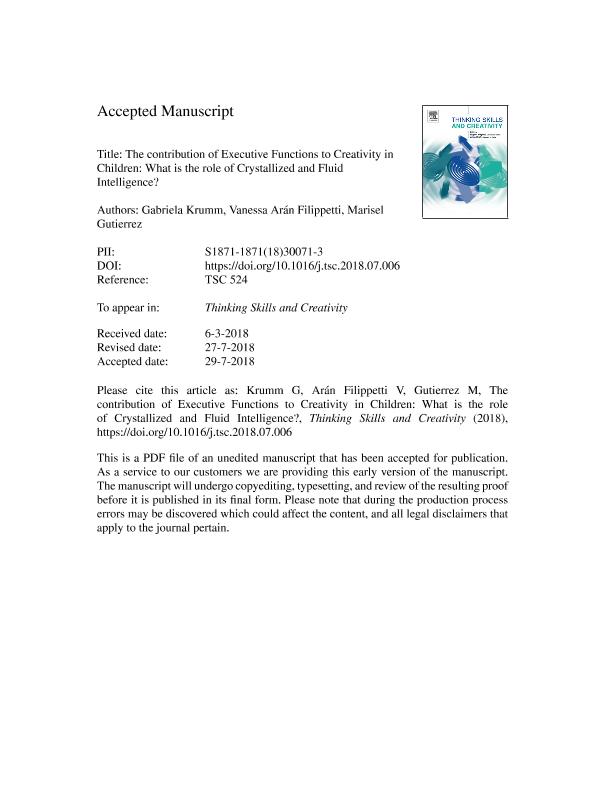Mostrar el registro sencillo del ítem
dc.contributor.author
Krumm, Gabriela Liliana

dc.contributor.author
Arán Filippetti, Vanessa

dc.contributor.author
Gutierrez Saez, Marisel Luisa

dc.date.available
2020-01-20T20:10:28Z
dc.date.issued
2018-09
dc.identifier.citation
Krumm, Gabriela Liliana; Arán Filippetti, Vanessa; Gutierrez Saez, Marisel Luisa; The contribution of executive functions to creativity in children: What is the role of crystallized and fluid intelligence?; Elsevier; Thinking Skills and Creativity; 29; 9-2018; 185-195
dc.identifier.issn
1871-1871
dc.identifier.uri
http://hdl.handle.net/11336/95287
dc.description.abstract
Recent studies have revealed that intelligence and executive functions (EFs) play an important role in creative thinking. However, most research has focused on adult populations, without providing enough clarity as regards the way this complex relationship is manifested in children. The present study broadens and deepens the scope of previous research concerning children, analyzing the relationship between creativity, intelligence and EF, and examining the bond between the three constructs through an Structural Equation Modeling (SEM) approach. A total of 209 8- to 13-year-olds of both sexes (boys n = 86, girls n = 123) were administered measures of creativity, crystallized (Gc) and fluid intelligence (Gf) and EFs (i.e., working memory, inhibition and shifting). Correlational analyses revealed associations between all cognitive variables under study. After controlling for the child's level of intelligence, only shifting and inhibition continued to make a significant contribution to creativity. Moreover, SEM results indicated that the effect of Gc on creativity was mediated by shifting. These findings suggest that EFs differently support creativity in children and that shifting is a more powerful predictor of creativity than fluid and crystallized intelligence.
dc.format
application/pdf
dc.language.iso
eng
dc.publisher
Elsevier

dc.rights
info:eu-repo/semantics/openAccess
dc.rights.uri
https://creativecommons.org/licenses/by-nc-nd/2.5/ar/
dc.subject
CHILDHOOD
dc.subject
CREATIVITY
dc.subject
EXECUTIVE FUNCTIONS
dc.subject
INTELLECTUAL ABILITIES
dc.subject
SEM
dc.subject.classification
Otras Psicología

dc.subject.classification
Psicología

dc.subject.classification
CIENCIAS SOCIALES

dc.title
The contribution of executive functions to creativity in children: What is the role of crystallized and fluid intelligence?
dc.type
info:eu-repo/semantics/article
dc.type
info:ar-repo/semantics/artículo
dc.type
info:eu-repo/semantics/publishedVersion
dc.date.updated
2019-10-16T17:35:54Z
dc.journal.volume
29
dc.journal.pagination
185-195
dc.journal.pais
Países Bajos

dc.journal.ciudad
Amsterdam
dc.description.fil
Fil: Krumm, Gabriela Liliana. Consejo Nacional de Investigaciones Científicas y Técnicas. Oficina de Coordinación Administrativa Saavedra 15. Centro Interdisciplinario de Investigaciones en Psicología Matemática y Experimental Dr. Horacio J. A. Rimoldi; Argentina
dc.description.fil
Fil: Arán Filippetti, Vanessa. Consejo Nacional de Investigaciones Científicas y Técnicas. Oficina de Coordinación Administrativa Saavedra 15. Centro Interdisciplinario de Investigaciones en Psicología Matemática y Experimental Dr. Horacio J. A. Rimoldi; Argentina
dc.description.fil
Fil: Gutierrez Saez, Marisel Luisa. Consejo Nacional de Investigaciones Científicas y Técnicas. Oficina de Coordinación Administrativa Saavedra 15. Centro Interdisciplinario de Investigaciones en Psicología Matemática y Experimental Dr. Horacio J. A. Rimoldi; Argentina
dc.journal.title
Thinking Skills and Creativity
dc.relation.alternativeid
info:eu-repo/semantics/altIdentifier/url/https://www.sciencedirect.com/science/article/pii/S1871187118300713
dc.relation.alternativeid
info:eu-repo/semantics/altIdentifier/doi/http://dx.doi.org/10.1016/j.tsc.2018.07.006
Archivos asociados
